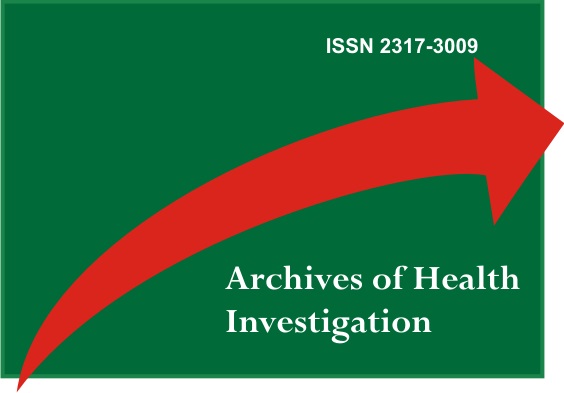Identification and surgical removal of supernumerary teeth: case report
DOI:
https://doi.org/10.21270/archi.v10i5.4965Keywords:
Tooth, Supernumerary, Diagnosis, Surgery, OralAbstract
Supernumerary teeth are those that develop in the jaws in addition to normal teeth. These teeth are more frequent in permanent dentition and, in some cases, are associated with systemic diseases and syndromes. This study aimed to report a clinical case, emphasizing the importance of early diagnosis of supernumerary teeth to avoid complex and difficult-to-solve problems related to impaired aesthetics due to smile disharmony and the establishment of correct occlusion. Leukoderma patient, male, 9 years old, sought care accompanied by the responsible, having as main complaint the existence of a “atrophied tooth” between the upper central incisors and a compromise in aesthetics due to disharmony of the smile. After the anamnesis was performed, a clinical examination was performed, and the presence of a mesiodent was verified, causing diastema between the incisors and marked vestibularization of the element 21, contributing to an absence of adequate lip sealing. Periapical radiographs of the area, an occlusal radiography and an orthopantomography were performed. It was observed that in addition to the presence of a supernumerary element in the anterior (mesiodent) region, there was another supernumerary tooth included in the antero-median region of the palate. Based on the clinical and radiographic exams, we opted for the surgical removal of supernumeraries. Supernumerary teeth are a dental number anomaly that may appear erupted or included and, in addition, may be related to syndromes or systemic diseases. Thus, there is a need for an accurate diagnosis and, in most cases, surgical removal of excess teeth.
Downloads
References
Nunes KM, Medeiros MV, Ceretta LB, Simões PW, Azambuja FG, Sônego FGF et al. Dente supranumerário: revisão bibliográfica e relato de caso clínico. Rev Odontol Univ Sao Paulo. 2015;27:72-81.
Mukhopadhyay S. Mesiodens: a clinical and radiographic study in children. J Indian Soc Pedod Prev Dent. 2011;29:34-8
Cunha Filho JJ, Puricelli E, Hennigen TW, Leite MGT, Pereira MA, Martins GL. Ocorrência de dentes supranumeráriosem pacientes do serviço de Cirurgia e Traumatologia Buco-Maxilo--Facial, Faculdade de Odontologia da UFRGS, no período de 1998 a 2001.Rev Fac Odontol Porto Alegre. 2002;43:27-34.
Fernandes AV, Rocha NS, Almeida RAC, Silva EDO, Vasconcelos BCE. Quarto molar incluso: relato de caso. Rev cir traumatol buco-maxilo-fac. 2005;5:61-6.
Leite Segundo AV, Faria DLB, Silva UH, Vieira ÍTA. Estudo epidemiológico de dentes supranumerários diagnosticados pela radiografia panorâmica. Rev cir traumatol buco-maxilo-fac. 2006;6:53-6.
Parolia A, Kundabala M, Dahal M, Mohan M, Thomas MS. Management of supernumerary teeth. J Conserv Dent. 2011;14:221-24.
Schmuckli R, Lipowsky C, Peltomäki T. Prevalence and morphology of supernumerary teeth in the population of a swiss community. Schweiz Monatsschr Zahnmed. 2012;120:987-90.
Marchetti G, Oliveira RV. Mesiodens - dentes supranumerários: diagnóstico, causas e tratamento. Uningá Review. 2015;24:19-23.
Wang XP, Fan J. Molecular genetics of supernumerary tooth formation. Genesis. 2011;49:261–77.
Ramesh K, Venkataraghavan K, Kunjappan S, Ramesh M. Mesiodens: a clinical and radiographic study of 82 teeth in 55 children below 14 years. J Pharm BioAllied Sci. 2013;5:60-2.
Stringhini Junior E, Stang B, Oliveira LB. Dentes supranumerários impactados: relato de caso clínico. Rev Assoc Paul Cir Dent. 2015;69:89-94.
Garvey MT, BarryHJ,Blake M. Supernumerary teeth-an over view of classification, diagnosis and management. J Can Dent Assoc. 1999;65:612-16.
Mason C, Rule D, Hopper C. Multiple supernumeraries: the importance of clinical and radiographic follow-up. Dentomaxillofac Radiol. 1996;25:109-13.
Almeida CM, Pereira EL, Carvalho DA, Silva Júnior SE, Lima VPR, Araújo Filho JCWP. Exodontia de elemento supranumerário incluso e impactado localizado na mandíbula. Arch Health Invest. 2018:7 (Special Issue 1):27.
Teslenco VB, Gaetti Jardim EC, Silva JCL. Supranumerários bilaterais em mandíbula: relato de caso. Arch Health Invest. 2017:6 (3):110-14.


